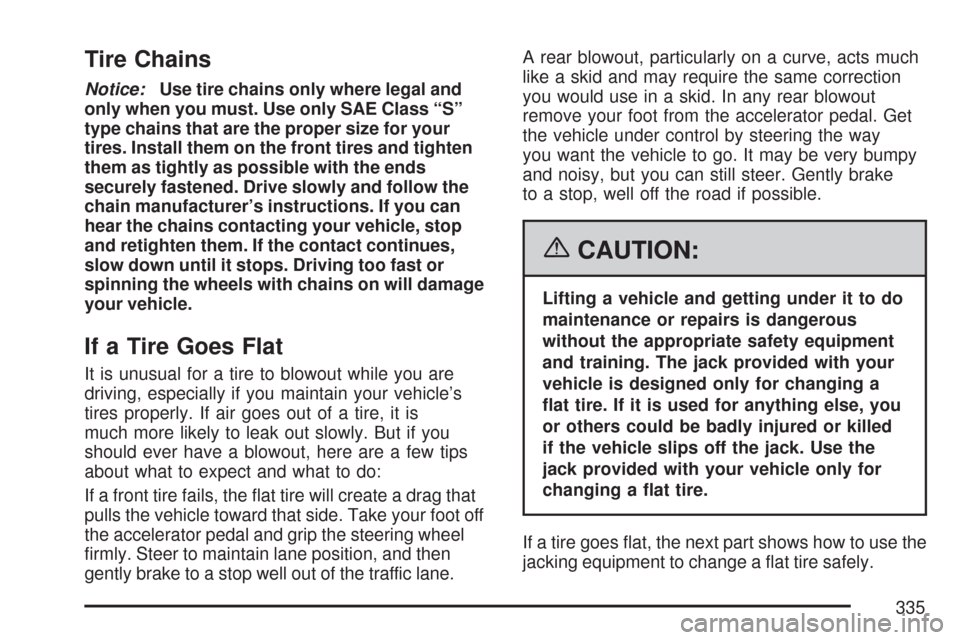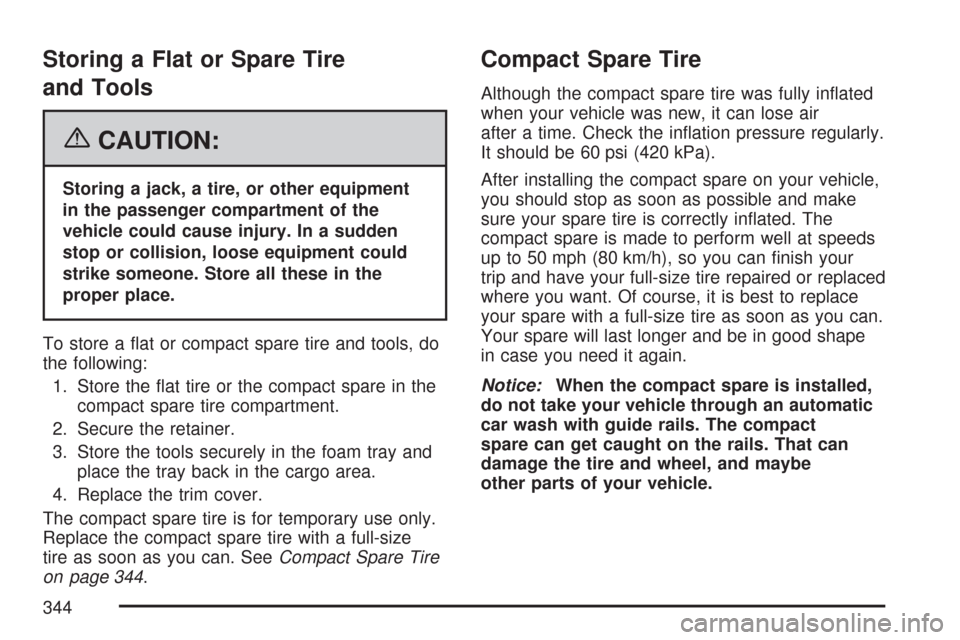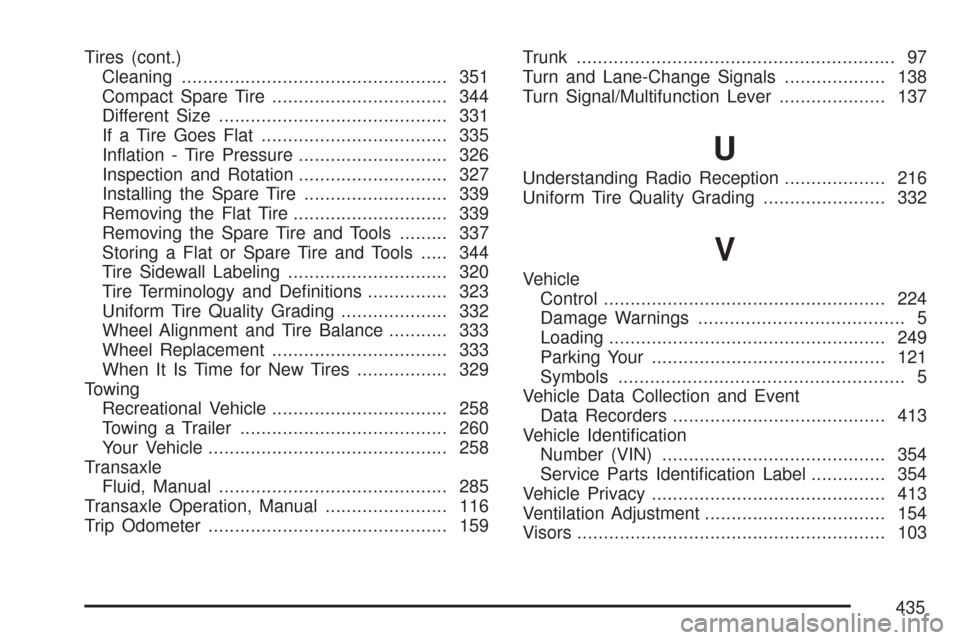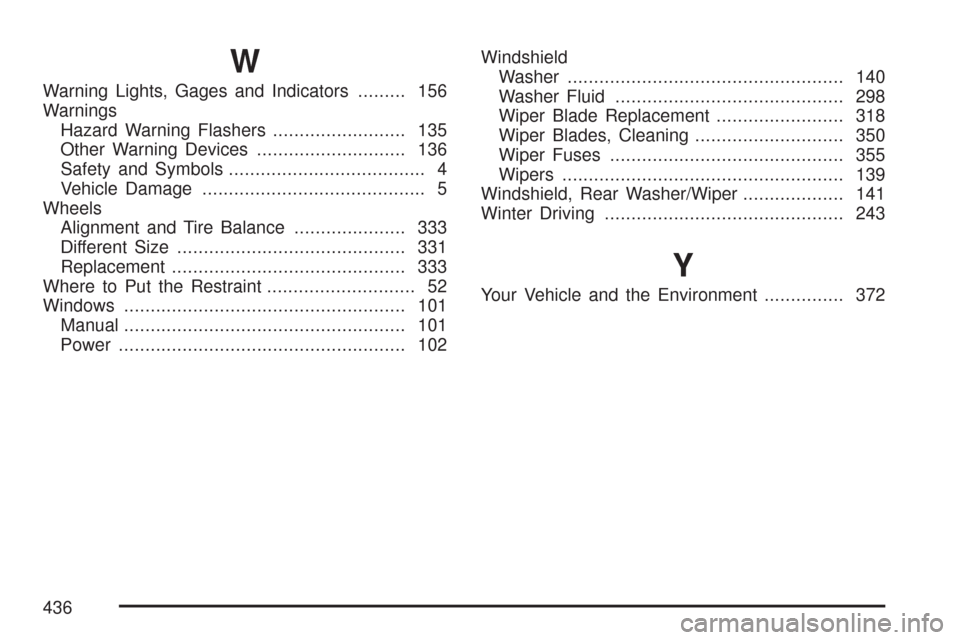Page 335 of 436

Tire Chains
Notice:Use tire chains only where legal and
only when you must. Use only SAE Class “S”
type chains that are the proper size for your
tires. Install them on the front tires and tighten
them as tightly as possible with the ends
securely fastened. Drive slowly and follow the
chain manufacturer’s instructions. If you can
hear the chains contacting your vehicle, stop
and retighten them. If the contact continues,
slow down until it stops. Driving too fast or
spinning the wheels with chains on will damage
your vehicle.
If a Tire Goes Flat
It is unusual for a tire to blowout while you are
driving, especially if you maintain your vehicle’s
tires properly. If air goes out of a tire, it is
much more likely to leak out slowly. But if you
should ever have a blowout, here are a few tips
about what to expect and what to do:
If a front tire fails, the flat tire will create a drag that
pulls the vehicle toward that side. Take your foot off
the accelerator pedal and grip the steering wheel
firmly. Steer to maintain lane position, and then
gently brake to a stop well out of the traffic lane.A rear blowout, particularly on a curve, acts much
like a skid and may require the same correction
you would use in a skid. In any rear blowout
remove your foot from the accelerator pedal. Get
the vehicle under control by steering the way
you want the vehicle to go. It may be very bumpy
and noisy, but you can still steer. Gently brake
to a stop, well off the road if possible.
{CAUTION:
Lifting a vehicle and getting under it to do
maintenance or repairs is dangerous
without the appropriate safety equipment
and training. The jack provided with your
vehicle is designed only for changing a
�at tire. If it is used for anything else, you
or others could be badly injured or killed
if the vehicle slips off the jack. Use the
jack provided with your vehicle only for
changing a �at tire.
If a tire goes flat, the next part shows how to use the
jacking equipment to change a flat tire safely.
335
Page 344 of 436

Storing a Flat or Spare Tire
and Tools
{CAUTION:
Storing a jack, a tire, or other equipment
in the passenger compartment of the
vehicle could cause injury. In a sudden
stop or collision, loose equipment could
strike someone. Store all these in the
proper place.
To store a flat or compact spare tire and tools, do
the following:
1. Store the flat tire or the compact spare in the
compact spare tire compartment.
2. Secure the retainer.
3. Store the tools securely in the foam tray and
place the tray back in the cargo area.
4. Replace the trim cover.
The compact spare tire is for temporary use only.
Replace the compact spare tire with a full-size
tire as soon as you can. SeeCompact Spare Tire
on page 344.
Compact Spare Tire
Although the compact spare tire was fully inflated
when your vehicle was new, it can lose air
after a time. Check the inflation pressure regularly.
It should be 60 psi (420 kPa).
After installing the compact spare on your vehicle,
you should stop as soon as possible and make
sure your spare tire is correctly inflated. The
compact spare is made to perform well at speeds
up to 50 mph (80 km/h), so you can finish your
trip and have your full-size tire repaired or replaced
where you want. Of course, it is best to replace
your spare with a full-size tire as soon as you can.
Your spare will last longer and be in good shape
in case you need it again.
Notice:When the compact spare is installed,
do not take your vehicle through an automatic
car wash with guide rails. The compact
spare can get caught on the rails. That can
damage the tire and wheel, and maybe
other parts of your vehicle.
344
Page 435 of 436

Tires (cont.)
Cleaning.................................................. 351
Compact Spare Tire................................. 344
Different Size........................................... 331
If a Tire Goes Flat................................... 335
Inflation - Tire Pressure............................ 326
Inspection and Rotation............................ 327
Installing the Spare Tire........................... 339
Removing the Flat Tire............................. 339
Removing the Spare Tire and Tools......... 337
Storing a Flat or Spare Tire and Tools..... 344
Tire Sidewall Labeling.............................. 320
Tire Terminology and Definitions............... 323
Uniform Tire Quality Grading.................... 332
Wheel Alignment and Tire Balance........... 333
Wheel Replacement................................. 333
When It Is Time for New Tires................. 329
Towing
Recreational Vehicle................................. 258
Towing a Trailer....................................... 260
Your Vehicle............................................. 258
Transaxle
Fluid, Manual........................................... 285
Transaxle Operation, Manual....................... 116
Trip Odometer............................................. 159Trunk............................................................ 97
Turn and Lane-Change Signals................... 138
Turn Signal/Multifunction Lever.................... 137
U
Understanding Radio Reception................... 216
Uniform Tire Quality Grading....................... 332
V
Vehicle
Control..................................................... 224
Damage Warnings....................................... 5
Loading.................................................... 249
Parking Your............................................ 121
Symbols...................................................... 5
Vehicle Data Collection and Event
Data Recorders........................................ 413
Vehicle Identification
Number (VIN).......................................... 354
Service Parts Identification Label.............. 354
Vehicle Privacy............................................ 413
Ventilation Adjustment.................................. 154
Visors.......................................................... 103
435
Page 436 of 436

W
Warning Lights, Gages and Indicators......... 156
Warnings
Hazard Warning Flashers......................... 135
Other Warning Devices............................ 136
Safety and Symbols..................................... 4
Vehicle Damage.......................................... 5
Wheels
Alignment and Tire Balance..................... 333
Different Size........................................... 331
Replacement............................................ 333
Where to Put the Restraint............................ 52
Windows..................................................... 101
Manual..................................................... 101
Power...................................................... 102Windshield
Washer.................................................... 140
Washer Fluid........................................... 298
Wiper Blade Replacement........................ 318
Wiper Blades, Cleaning............................ 350
Wiper Fuses............................................ 355
Wipers..................................................... 139
Windshield, Rear Washer/Wiper................... 141
Winter Driving............................................. 243
Y
Your Vehicle and the Environment............... 372
436